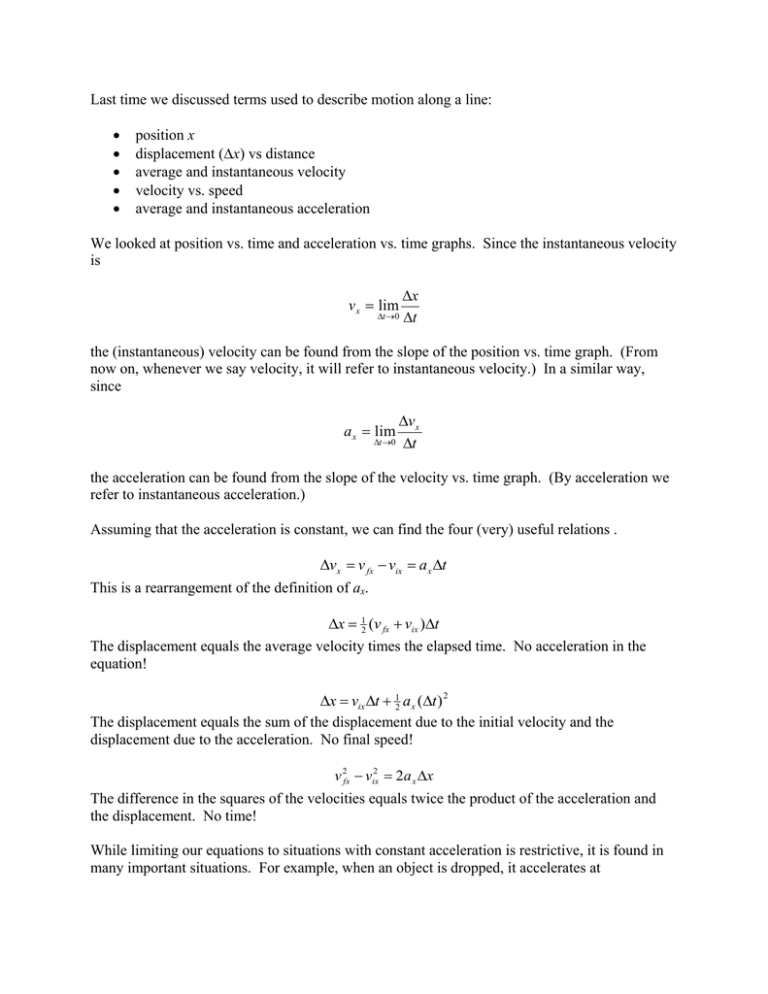Last time we discussed terms used to describe motion along... x displacement (
advertisement

Last time we discussed terms used to describe motion along a line: position x displacement (x) vs distance average and instantaneous velocity velocity vs. speed average and instantaneous acceleration We looked at position vs. time and acceleration vs. time graphs. Since the instantaneous velocity is x t 0 t v x lim the (instantaneous) velocity can be found from the slope of the position vs. time graph. (From now on, whenever we say velocity, it will refer to instantaneous velocity.) In a similar way, since v x t 0 t a x lim the acceleration can be found from the slope of the velocity vs. time graph. (By acceleration we refer to instantaneous acceleration.) Assuming that the acceleration is constant, we can find the four (very) useful relations . v x v fx vix a x t This is a rearrangement of the definition of ax. x 12 (v fx vix )t The displacement equals the average velocity times the elapsed time. No acceleration in the equation! x vix t 12 a x (t ) 2 The displacement equals the sum of the displacement due to the initial velocity and the displacement due to the acceleration. No final speed! v 2fx vix2 2a x x The difference in the squares of the velocities equals twice the product of the acceleration and the displacement. No time! While limiting our equations to situations with constant acceleration is restrictive, it is found in many important situations. For example, when an object is dropped, it accelerates at g = 9.8 m/s2 But in general, motion is not just along a line. How do we deal with that? Introduce vectors and scalars. Vectors have direction as well as magnitude. They are represented by arrows. The arrow points in the direction of the vector and its length is related to the vector’s magnitude. Scalars only have magnitude. We write A = B if the vectors have the same magnitude and point in the same direction. Scalars can have magnitude, algebraic sign, and units. Adding scalars is very familiar. You add 10 grams to 15 grams and get 25 grams. You have $20 and give $5 to friend and you have $15 remaining. Vector addition is different since vectors have direction as well as magnitude. How do we add vectors? We have already know how to add vectors in one dimension (along the x-axis for example). A B A+B What happened? The vector B is positioned so that the tail of B is positioned at the head of A. The vector sum is drawn from the tail of A to the head of B. If A is 8 m long and B is 10 m long, the magnitude of A+B is 18 m. What if B is reversed? B A+B A What is the magnitude of A+B? Here we see a hint of the problem. Vector do not add like scalars. How do we add vectors that do not point along the same direction? 1. Draw the first vector in the correct direction and with the appropriate magnitude. 2. Draw the second vector with the correct direction and magnitude so that its tail is placed at the head of the first vector. 3. If there is a third vector, draw it with the correct direction and magnitude to that its tail is placed at the head of the second vector. 4. When finished with all the vectors, find the vector sum by drawing a vector that starts at the tail of the first vector and ends at the head of the last vector. How do we subtract vectors? Use A−B = A+(−B). What is a reasonable definition for –B? The negative of a vector has the same magnitude as the original vector but points in the opposite direction. The idea of vectors is built from the idea of displacement. In the diagram above, imagine that you are in a forest. A is your walk to a tree and B is your walk from the first tree to a friend you see across the forest. A+B is your net displacement from your starting point. Another example: This procedure is called the graphical addition of vectors. You need to understand this procedure. However, it is too slow and imprecise to be used in solving problems. We add vectors by taking their components. The process is summarized in this figure. We are adding two vectors that are not collinear. We replace each vector with two vectors (called its components). We then add like components together, giving the components of the vector sum. What happens next? C Cy Cx We add Cx and Cy to find C. Since the x- and y-axes are perpendicular, we can find the magnitude of C from the Pythagorean theorem, C Cx C y 2 2 The direction is normally measured counterclockwise from the +x-axis. For this vector in the 2nd quadrant, first find arctan Cy Cx and then subtract from 180º. (Why?) How do we find the components of a vector? As an example suppose A has magnitude 20 N and it points at 40º. As the following diagram shows, we are dealing with a right triangle. To find the components we need to use trigonometry. Recall, cos adjacent hypotenuse sin opposite hypotenuse tan opposite adjacent y =40o x Using the definitions of cosine and sine, cos A adjacent x hypotenuse A Ax A cos (20 N) cos 40 15.3 N sin Ay opposite hypotenuse A Ay A sin (20 N) sin 40 12.9 N Why is Ax > Ay? When are they equal? Suppose we had this picture. What would you do? y =50o x Ax (20 N) sin 50 15.3 N Ay (20 N) cos 50 12.9 N Usually we have cosine associated with x-components and sine associated with y-components, but not always. You have to look at the diagram. (A very common remark for this semester!) Problem-Solving Strategy: Finding the x- and y-components of a Vector from its Magnitude and Direction (page 60) 1. Draw a right triangle with the vector as the hypotenuse and the other two sides parallel to the x- and y-axes. 2. Determine one of the unknown angles in the triangle. 3. Use trigonometric functions to find the magnitudes of the components. Make sure your calculator is in “degree mode” to evaluate trigonometric functions of angles in degrees and in “radian mode” for angles in radians. 4. Determine the correct algebraic sign for each component. Problem-Solving Strategy: Finding the Magnitude and Direction of a Vector A from its xand y-components (page 60) 1. Sketch the vector on a set of x- and y-axes in the correct quadrant, according to the signs of the components. 2. Draw a right triangle with the vector as the hypotenuse and the other two sides parallel to the x- and y-axes. 3. In the right triangle, choose which of the unknown angles you want to determine. 4. Use the inverse tangent function to find the angle. The lengths of the sides of the triangle represent |Ax| and |Ay|. If is opposite the side parallel the side perpendicular to the xaxis, then tan = opposite/adjacent = |Ax/Ay|. If is opposite the side parallel the side perpendicular to the y-axis, then tan = opposite/adjacent = |Ay/Ax|. If your calculator is in “degree mode,” then the result of the inverse tangent will be in degrees. [In general, the inverse tangent has has two possible values between 0 and 360º because tan = tan ( + 180º). However, when the inverse tangent is used to find one of the angles in a right triangle, the result can never be greater than 90º, so the value the calculator returns is the one you want. 5. Interpret the angle: specify whether it is the angle below the horizontal, or the angle west of south, or the angle clockwise from the negative y-axis, etc. 6. Use the Pythagorean theorem to find the magnitude of the vector. A Ax Ay 2 2 Problem-Solving Strategy: Adding Vectors Using Components (page 61) 1. Find the x- and y-components of each vector to be added. 2. Add the x-components (with their algebraic signs) of the vectors to find the x-component of the sum. (If the signs are not correct, the sum will not be correct. 3. Add the y-components (with their algebraic signs) of the vectors to find the y-component of the sum. 4. If necessary, use the x- and y-components of the sum to find the magnitude and direction of the sum. Even when using the component method to add vectors, the graphical method is an important first step. Graphical addition gives you a mental picture of what is going on. A problem can be made easier to solve with a good choice of axes. Common choices are x-axis horizontal and y-axis vertical, when the vectors all lie in the vertical plane; x-axis east and y-axis north, when the vectors lie in a horizontal plane; and x-axis parallel to an inclined surface and y-axis perpendicular to it. Read the section on unit vectors on pages 62-63. We will not use the unit vector approach, but you may be familiar with it. Now let’s use the concept of vectors to extend the kinematical variables to more dimensions. Average velocity is the displacement over the time, r v av t Instantaneous velocity is r v lim t 0 t The velocity is tangent to the path of the particle. The average acceleration is v a av t Instantaneous acceleration is v a lim t 0 t “For straight-line motion the acceleration is always along the same line as the velocity. For motion in two dimensions, the acceleration vector can make any angle with the velocity vector because the velocity vector and change in magnitude, in direction, or both. The direction of the acceleration is the direction of the change in velocity v during a very short time.” The above definitions look good, but they are not useful. We call these formal definitions. They are not used in solving problems. Instead we need a set of definitions for the x- and ycomponents. The basic rule is WE DO NOT DEAL WITH VECTORS. WE DEAL WITH THEIR COMPONENTS. For the velocity, we have v x ,av x t v y ,av y t with similar definitions for the other parameters. (See pages 64-65.) We can now generalize the equations at the top of these notes to two dimensions. “It is generally easiest to choose the axes so that the acceleration has only one non-zero component.” We choose the y-axis along the direction of acceleration. This means ax = 0. v x v fx vix a x t becomes v x 0 v y v fy viy a y t and x 12 (v fx vix )t becomes x v x t y 12 (v fy viy )t and x vix t 12 a x (t ) 2 becomes x v x t and y v y t 12 a y (t ) 2 v 2fx vix2 2a x x becomes v 2fx vix2 0 and v 2fy viy2 2a y y Summary: x-axis : ax = 0 v x 0 y-axis: constant ay v y v fy viy a y t x v x t y 12 (v fy viy )t (3-20) y v y t 12 a y (t ) 2 (3-21) v 2fy viy2 2a y y (3-22) Equation (3-19) Projectiles are a good example of this type of motion. Here ay = −g. This motion is simultaneous constant velocity in the x-direction and constant acceleration in the y-direction.



